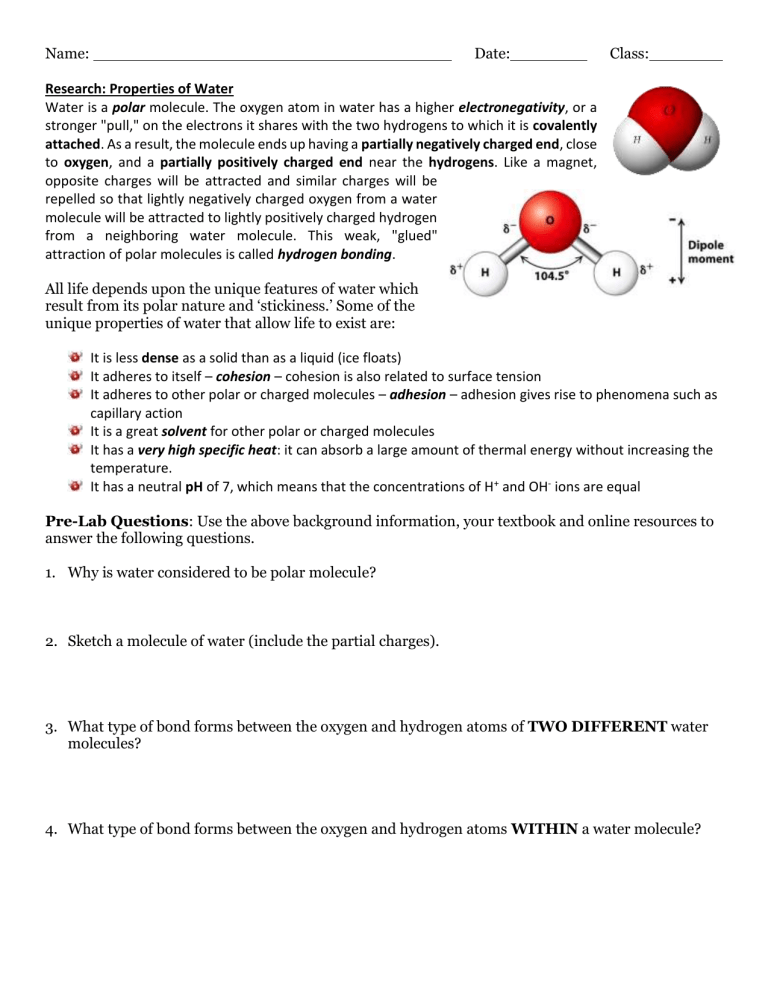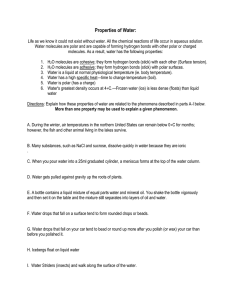
Name: Date: Class: Research: Properties of Water Water is a polar molecule. The oxygen atom in water has a higher electronegativity, or a stronger "pull," on the electrons it shares with the two hydrogens to which it is covalently attached. As a result, the molecule ends up having a partially negatively charged end, close to oxygen, and a partially positively charged end near the hydrogens. Like a magnet, opposite charges will be attracted and similar charges will be repelled so that lightly negatively charged oxygen from a water molecule will be attracted to lightly positively charged hydrogen from a neighboring water molecule. This weak, "glued" attraction of polar molecules is called hydrogen bonding. All life depends upon the unique features of water which result from its polar nature and ‘stickiness.’ Some of the unique properties of water that allow life to exist are: It is less dense as a solid than as a liquid (ice floats) It adheres to itself – cohesion – cohesion is also related to surface tension It adheres to other polar or charged molecules – adhesion – adhesion gives rise to phenomena such as capillary action It is a great solvent for other polar or charged molecules It has a very high specific heat: it can absorb a large amount of thermal energy without increasing the temperature. It has a neutral pH of 7, which means that the concentrations of H+ and OH- ions are equal Pre-Lab Questions: Use the above background information, your textbook and online resources to answer the following questions. 1. Why is water considered to be polar molecule? 2. Sketch a molecule of water (include the partial charges). 3. What type of bond forms between the oxygen and hydrogen atoms of TWO DIFFERENT water molecules? 4. What type of bond forms between the oxygen and hydrogen atoms WITHIN a water molecule? Question: How will soap affect the hydrogen bonds between different water molecules? Hypothesis: Materials: Penny, water, soap, pipette, paper towel Procedure: 1. Obtain a DRY penny and place it on a DRY paper towel. 2. Using a clean pipette, add water to the penny drop by drop until it overflows. Be sure to count the drops! Record the number of drops for Trial 1 in Data Table 1 below. 3. Repeat steps 1-2 for a total of three trials. 4. Place 2 drops of soap in 50 ml of water to create a solution. 5. Repeat steps 1-2 for a total of three trials. Data Collection: Data Table 1: Number of Drops of Distilled Water Contained on the Surface of a Penny Trial # Drops Water # Drops Water + Soap # Drops Water + Alcohol 1 2 3 Trial Average (Add the three trials and divide by 3) 2 Graph Data: 1. Make a Claim about how soap affects hydrogen bonds between water molecules. 2. Using data from this experiment, provide Evidence from your investigation that supports the claim(s). 3. Using background knowledge and data from this lab, provide Reasoning that uses the evidence to justify the claim and comment on how confident you are in your conclusions. Here, you may want to include deductive reasoning that uses the properties of water to explain why you obtained the results. 4. Suggest another experiment that you could perform that deals with surface tension. Write your question/hypothesis below and a brief description of how you would conduct the experiment. 3





